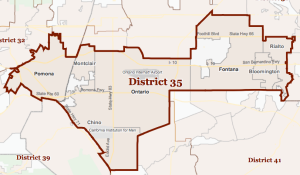Editor’s note: The presidential nominating contests in both parties will come down to the California primary.
For Democrats, 548 delegates are at stake — 11.5% of the total. For Republicans, 172 delegates are at stage — 6.9% of the total. Of those, for Democrats, 158 (29%) are divided proportionally on a statewide basis, while 317 (58%) are divided proportionally by congressional district, with each district providing between 5 and 8 delegates. The remaining 73 (13%) are “superdelegates.”
For Republicans, 13 (8%) are awarded statewide, with ten going to the candidate with the highest number of votes on a winner-take-all basis, and three going to “pre-determined” delegates (the State Chair, National Committeewoman, National Committeeman). Meanwhile, 159 (92%) are awarded by congressional district on a winner-take-all basis, with each district providing 3 delegates.
The result: a district-by-district battle in both parties, which we preview for you here.
CA-35: This district is over 70% Latino and a relatively safe seat for Democrat Norma Torres. It includes Ontario Airport — the budget traveler’s alternative to LAX — and much industry besides. While it includes a sliver of Los Angeles County, the district is almost entirely within Riverside County and is considered an “Inland Empire” district. This is, however, one of the less conservative portions of that region, compared to regions further east.
Prospects:
Democrats: The demographic makeup of the district strongly favors Clinton, though Sanders will pick up a delegate.
Clinton 4, Sanders 1
Republicans: Cruz tends to do better among Latinos, but many Latinos here vote Democrat. Narrow win for Trump.
Trump 3, Cruz 0, Kasich 0
Joel B. Pollak is Senior Editor-at-Large at Breitbart News. His new e-book, Leadership Secrets of the Kings and Prophets: What the Bible’s Struggles Teach Us About Today, is on sale through Amazon Kindle Direct. Follow him on Twitter at @joelpollak.


COMMENTS
Please let us know if you're having issues with commenting.